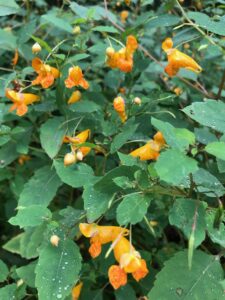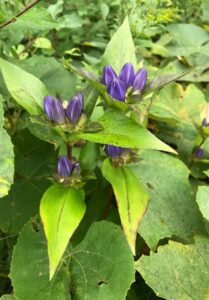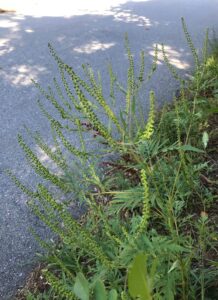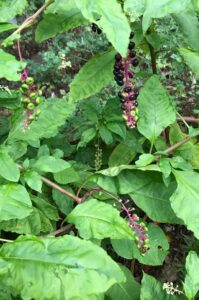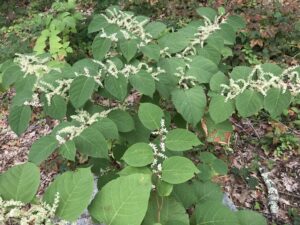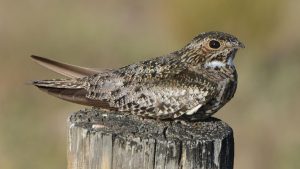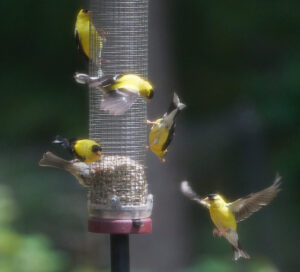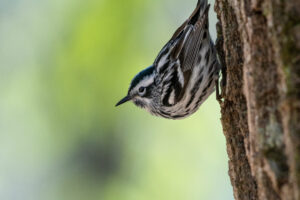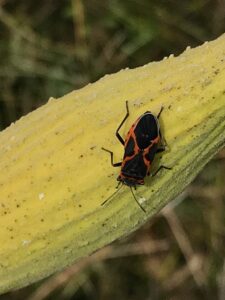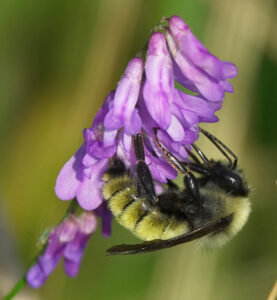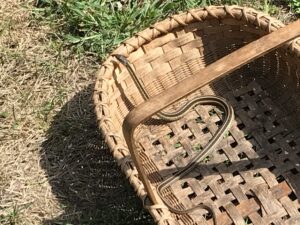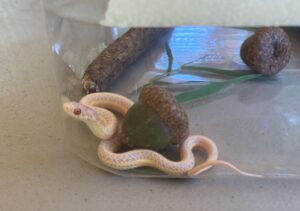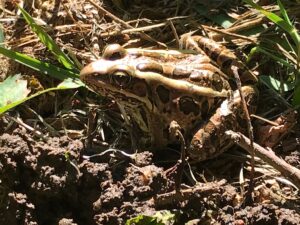Written by Gwyn Loud for the Lincoln Land Conservation Trust. She welcomes your sightings and questions at 781-259-8690 or gwynloud555@gmail.com
The official start of the new season will come on September 22, the autumnal equinox, but fall is already in the air, signaled by earlier sunsets and cooler nights. According to the US Drought Monitor, we remain in moderate drought in spite of steady rain on August 29. The UMass Amherst Landscape Message states that for the metro-west region, “for August, the historical monthly average precipitation is 3.72” but only a total of 1.84” of rain was recorded for the month. The historical monthly average precipitation for September is 3.77”, but as of this writing (Sept. 8) no rainfall has occurred. Many small streams are totally dry and I was sad to see milkweed plants dying in fields from lack of water.
Plants of all sorts are producing berries, seeds, and nuts, to the benefit of wildlife. Seeds have different “strategies” for traveling to grow in new locations. For instance, poison ivy pops up in unexpected places when birds eat the seeds, the seeds are excreted in their droppings, and voila! A new PI plant sprouts. Seeds from plants such as milkweed and the invasive black swallow-wort blow through the air to land on fertile ground, and burrs such as burdock attach to any passing animal for a ride. Other seeds may float on water, and some invasives get spread when construction equipment or mowers inadvertently transport seeds to new locations. When you do garden clean-up please leave some plants with seed heads standing as food for wildlife.
Jewelweed (aka touch-me-not) is blooming now, an important nectar source for hummingbirds, and cardinal flowers can still be found along streams. Ragweed’s inconspicuous flowers are usually the culprits causing allergies, but the showier goldenrod often gets the blame unfairly. Several species of white and lavender asters are blooming and some wet meadows are carpeted with a tangle of tearthumb, with its tiny white flowers and prickly stems. The beautiful blue closed gentian (follow the link for a video of a bumblebee visiting this flower) is flowering now and pokeweed, a popular food of birds, is hard to miss with purple berries and magenta stems. You will see the invasive shrub Japanese knotweed blooming; look for the drooping spikes of white flowers along roadsides. In weedy spots you can find smartweed (pink) and hawkweed (yellow) in bloom and in the woods watch for the red berries of jack-in-the pulpit and partridgeberry. Un-mowed fields are colorful with goldenrod, Joe-Pye weed, and Queen Anne’s Lace.
Birds have started their fall migration. One day we suddenly realize that birds such as barn swallows or orioles, which we have loved all summer, have gone without saying good-bye. Some of our summer residents make migrations for thousands of miles and others go only a few hundred miles or less. Bobolinks, for example, fly all the way to Argentina but some red-winged blackbirds may only go as far as the mid-Atlantic states. As I write, eight young robins, still with spotted breasts, are busy splashing in the birdbath and tonight they will probably continue their southward journey. Recently a flock of about one hundred migrating common nighthawks passed over the Flint Farm at dusk, some birds dipping down to feed on dragonflies over the pond. Nighthawks are not hawks but are members of the nightjar family, having wide mouths surrounded by feather shafts which help funnel insects into the mouth as the bird flies. Raptors such as broad-winged hawks are migrating in September; listen for their one-pitch thin high whistle overhead.
Another of our favorite summer residents about to leave us is the ruby-throated hummingbird. They are now in feeding-frenzy mode to build up fat to prepare to fly as far as 3,500 miles to Central America. Some fly along the coast of the Gulf of Mexico but others fly non-stop 500 miles across the Gulf. The birds can double their weight in seven to ten days as they prepare to migrate. The males depart first and, as explained on JourneyNorth, “Early male departure is actually beneficial to females and juveniles: with males gone, females and juveniles can feed without competing for food with the larger, more territorial males. … Newly-fledged birds need the time to mature and gain fat reserves before flying off on their first migration south.” It’s always a miracle to me that instinct tells juvenile birds their route and destination, with no adult bird to lead them.
A couple of people have reported bald cardinals and blue jays. Not to worry! They are not sick. During normal molting some blue jays and cardinals lose all their head feathers at one time and in a few weeks the new feathers will grow in. Notable recent bird sightings include two black vultures (turkey vultures are more common), a northern waterthrush, a pigeon near a Farrar Pond home, a number of red-breasted nuthatches, and common loons for several weeks on both Flint’s Pond and Walden Pond. Several nearby residents have reported hearing the loons calling often, a sound we associate more with Maine or New Hampshire.
We continue to hear the hum of insects on warm days and in the evening listen for the evenly spaced chirps of the snowy tree cricket, the chirps slowing as the temperature drops. One can actually tell the Fahrenheit temperature by counting the chirps in fourteen seconds and adding forty. Try it! The relationship between the speed of the cricket’s chirps and the temperature is called Dolbear’s Law. A Concord Rd. resident had a lot of brown moths on the screened porch recently, most likely copper underwing moths. While looking in vain for monarch caterpillars a couple of weeks ago I found many small Eastern milkweed bugs feeing on milkweed pods. The bug is not affected by the toxins in milkweed but is toxic to insect predators, who are warned off by the bug’s black and orange coloring. A good number of adult monarchs were sighted in August but only a few caterpillars have been reported. Monarchs hatching now will be the generation to make the long migration to Mexico where they will over-winter. To follow their progress or report sightings visit https://journeynorth.org/monarchs.
Norman Levey shares the following regarding bumblebees: “Volunteers are assessing bumblebee [or bumble bee] diversity, distribution, and behavior in relation to the flower ecology in Lincoln as a part of the LLCT’s Pollinator Action Plan: Planting the Way for Biodiversity and Climate Resilience, The data are submitted by volunteers and collected by Dr. Robert Gegear of The University of Massachusetts, Dartmouth by means of the citizen science project, Beecology which Dr. Gegear designed in collaboration with software engineers at Worcester Polytechnic Institute. The purpose of this project is to discover the cause or causes of decline of species diversity of pollinating native bees. Everyone is welcome to participate. The season for bumblebees is winding down but at least three or four species are still active; two species, Bombus perplexus and Bombus bimaculatus have a short reproduction cycle and their time frame or “phenology” closed when July turned to August. Look for large congregations of Bombus impatiens workers on flowers as this species is the most abundant in September. A few Bombus griseocollis, fervidus, and vagans are still being seen, the last two never very abundant throughout the season and may be threatened with local extinction. “
Gray tree frogs continue to be heard trilling sporadically and a resident found one outside on a window, using its sticky toe pads to hold to the glass. While weeding, I came across a beautiful pickerel frog and little toadlets and wood frogs hopping across lawns or through leaves are common at this season. Garter snakes seem abundant this year. One observer saw one eating an earthworm, I found one sunning in my garden basket and at Drumlin Farm an amelanistic one was found by a camp group. Amelanism means there is no melanin but other pigments are still present. Naturalist Mary Holland writes about garter snakes’ reproduction: “Seventy percent of the world’s snakes lay eggs and only about thirty percent give birth to live young. Eastern Garter Snakes (Thamnophis sirtalis sirtalis) are among the latter, giving birth in August to between two and thirty-one offspring (averaging 23). Carrying and incubating developing embryos within their body is more common for northern snakes and there is good reason for this. Whereas eggs are subject to whatever temperature fluctuations occur where they were laid, a snake that carries her young to term within her is able to move to warm areas that are ideal incubation temperatures. This causes less stress for the developing embryos and also results in a greater number of viable young.”
As for mammals, coyotes are giving their nightly yipping chorus in several parts of town and raccoons have been busy at night on grape arbors, devouring grapes, even before they are ripe. Dozens of chipmunks in my garden are likewise feasting on all my green tomatoes. At dusk watch for bats catching insects on the wing. There were a couple of sightings in mid-August of scrawny red foxes and coyotes which might have had mange. See this video for a possible sighting (mammal still unidentified). Skunks, woodchucks, rabbits, and deer have all been sighted. Those who follow Lincoln Talk know that recently, when the pest management plan for the construction site at the schools was published, a number of residents were upset to read that rodenticides would be used. This poison does not kill the rodent immediately but it wanders off to die slowly. Dogs walking nearby might catch the rodent or it might be eaten by a raptor, thus moving up the food chain, sometimes resulting in the death of the hawk or owl. Luckily, the School changed their plan in response to concerns and will now use snap traps instead of poison. I hope that any residents who poison rodents will reconsider; there are better methods, ones which are more humane for the rodents and safer for the environment. For more on this topic please go to https://blogs.massaudubon.org/distractiondisplays/tag/rodenticide-poisoning/.
© Gwyn Loud


